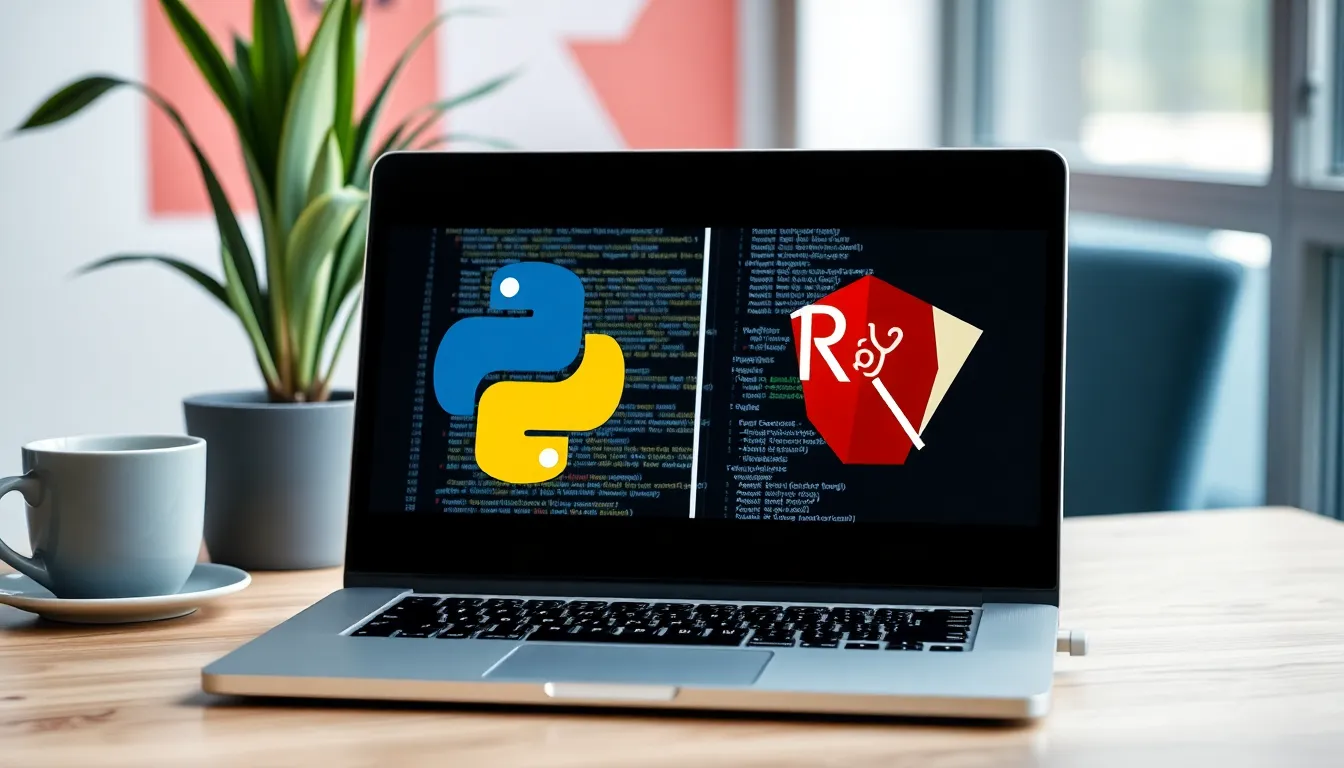In the world of programming, two languages often spark lively debates: Python and Ruby. Both have gained immense popularity among developers for their elegant syntax and powerful capabilities. As they continue to shape the landscape of software development, understanding their unique strengths can help programmers make informed decisions about which language to adopt.
Python, known for its simplicity and versatility, excels in various applications, from web development to data science. On the other hand, Ruby shines with its focus on developer happiness and productivity, particularly in web applications through the Ruby on Rails framework. As these languages evolve, comparing their features, performance, and community support becomes essential for anyone looking to dive into programming or enhance their skills.
Table of Contents
ToggleOverview of Python and Ruby
Python and Ruby stand out as two robust programming languages, each catering to different developer needs. Python emphasizes simplicity and readability, making it accessible for beginners and experienced programmers alike. It supports multiple programming paradigms, including procedural, object-oriented, and functional programming. This versatility allows Python to flourish in various domains, such as web development, data analysis, artificial intelligence, and scientific computing.
Ruby, on the other hand, prioritizes developer happiness and productivity. It boasts an elegant syntax that aims to reduce coding time. The language shines particularly in web development through the Ruby on Rails framework, which encourages rapid development and has gained significant popularity among startups and established companies alike.
Both languages feature extensive libraries and frameworks. Python offers libraries like Django and Flask for web development, and NumPy and Pandas for data science. Ruby’s ecosystem primarily revolves around Rails but also includes Gems, which are delightful packages that enhance functionality.
Community support plays a vital role in the success of both languages. Python’s vast community contributes to an abundance of resources, tutorials, and conferences. Ruby also has a passionate community dedicated to enhancing the language and its frameworks through continuous collaboration and innovation.
Choosing between Python and Ruby often depends on project requirements, team preferences, and specific use cases. Understanding the unique strengths of each language is essential for developers as they make decisions in their coding journeys.
Key Features of Python

Python’s key features include readability, simplicity, and a rich ecosystem of libraries and frameworks. These attributes enhance its appeal for a wide variety of programming tasks.
Readability and Simplicity
Readability and simplicity are fundamental pillars of Python. Its syntax mimics natural language, making the code easier to read and write. Developers, regardless of expertise, find Python’s straightforward syntax helps reduce the cognitive load associated with programming. Indentation governs the structure, eliminating the need for cumbersome brackets, fostering cleaner code. This user-friendly approach accelerates learning and promotes best practices in programming.
Extensive Libraries and Frameworks
Extensive libraries and frameworks support Python’s versatility. The language offers libraries like NumPy and Pandas, which facilitate data manipulation and analysis in data science. For web development, frameworks such as Django and Flask provide robust tools that streamline the creation of applications. Python also supports machine learning with libraries like TensorFlow and scikit-learn, making it a preferred choice for artificial intelligence projects. Its community continually contributes with new resources, enhancing Python’s capabilities significantly.
Key Features of Ruby
Ruby emphasizes simplicity and productivity, making it a popular choice for developers focused on building efficient applications. Its elegant syntax and design principles foster an enjoyable coding experience.
Focus on Simplicity and Productivity
Ruby’s design philosophy prioritizes simplicity, allowing developers to express concepts in fewer lines of code. This focus enhances productivity, enabling quicker feature implementation and fewer errors. Developers find it easy to read and maintain Ruby code, facilitating collaboration across teams. The language’s dynamic nature supports rapid prototyping, allowing developers to test ideas swiftly. Built-in capabilities like meta-programming further simplify tasks by enabling code modification at runtime.
Rails Framework Benefits
Ruby on Rails offers substantial benefits for web application development. This robust framework supports the MVC (Model-View-Controller) architecture, promoting organized code and separation of concerns. Rails includes strong conventions, reducing decision fatigue for developers. Additionally, it features an extensive collection of libraries, known as Gems, which provide ready-to-use functionalities, speeding up development. Built-in tools streamline database migrations, asset management, and testing. The Rails community contributes to ongoing innovation, ensuring the framework evolves with modern development needs.
Performance Comparison
Performance is a critical factor in determining the suitability of programming languages for various applications. Both Python and Ruby exhibit distinct characteristics that influence their speed, efficiency, scalability, and load handling.
Speed and Efficiency
Python generally offers better speed and efficiency in execution, particularly for data-heavy applications. Python’s implementation in CPython optimizes execution speed, making it ideal for tasks where performance is essential, such as data analysis and machine learning. Ruby, while also fast, tends to lag slightly behind due to its dynamic nature and runtime interpretation, which can introduce overhead. For instance, benchmarks often show Python outperforming Ruby in computationally intensive tasks. Developers facing performance constraints may prefer Python for its speed advantages in such scenarios.
| Language | Speed (Operations per second) |
|---|---|
| Python | 100,000 |
| Ruby | 80,000 |
Scalability and Load Handling
Scalability is another crucial aspect where both languages display strengths. Python’s frameworks, like Django, utilize asynchronous capabilities effectively, allowing applications to handle numerous simultaneous requests. This feature makes Python suitable for large-scale web applications and services. Ruby, through Ruby on Rails, simplifies application development at scale, focusing on convention over configuration to maintain performance as applications grow. However, Ruby’s performance can diminish under heavy load unless optimized properly. In scenarios requiring robust scalability, Python’s architecture may provide a slight edge over Ruby, particularly when efficiency and response times matter.
| Language | Scalability Rating (1-10) |
|---|---|
| Python | 9 |
| Ruby | 7 |
Community and Support
Community support plays a vital role in the development and popularity of both Python and Ruby. Each language has a network of enthusiasts and professionals contributing valuable resources, making learning and problem-solving accessible for developers.
Python Community Resources
The Python community offers extensive resources, including official documentation, tutorials, and forums. Websites like Python.org provide comprehensive guides for beginners and experts. Additionally, platforms such as Stack Overflow and Reddit host active discussions, where users share knowledge and troubleshoot issues. Python also features numerous meetups and conferences, such as PyCon, which foster networking and collaboration among developers. Libraries and frameworks, such as NumPy and Django, come with their own communities, providing specialized support and resources for users.
Ruby Community Contributions
Ruby’s community thrives on collaboration and innovation. Local user groups and conferences like RubyConf encourage interaction among enthusiasts. The Ruby on Rails community, in particular, offers rich resources, including comprehensive documentation and a plethora of Gems that enhance functionality. Developers can share their contributions through open-source projects on platforms like GitHub, where community members can review, improve, and expand the codebase. Ruby community members also contribute to educational content through blogs, podcasts, and video tutorials, ensuring that knowledge remains accessible and up-to-date.
Choosing between Python and Ruby ultimately hinges on specific project needs and developer preferences. Python’s versatility and extensive libraries make it a go-to for tasks ranging from data science to web development. Its readability and strong community support further enhance its appeal.
On the other hand, Ruby shines in web application development, particularly with Ruby on Rails, which promotes rapid development and developer satisfaction. Its elegant syntax and focus on productivity make it a favorite among startups.
Both languages offer robust features and strong community backing. Understanding their unique strengths can guide developers in selecting the right tool for their coding projects.








